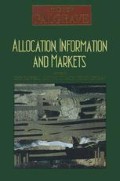Abstract
If product quality of individual units cannot be observed at the time of purchase, but buyers do eventually learn average quality, goods will be traded at a price which reflects buyers’ beliefs about this average. The price will then adjust until buyers’ beliefs about average quality are confirmed ex post.
Access this chapter
Tax calculation will be finalised at checkout
Purchases are for personal use only
Preview
Unable to display preview. Download preview PDF.
Bibliography
Akerlof, G.A. 1970. The market for ‘lemons’: qualitative uncertainty and the market mechanism. Quarterly Journal of Economics 84, August, 488–500.
Bhattacharya, S. 1980. Nondissipative signalling structures and dividend policy. Quarterly Journal of Economics 95, August, 1–24.
Cho, I.-K. and Kreps, D.M. 1987. Signalling games and stable equilibria. Quarterly Journal of Economics 102, May, 179–222.
Engers, M. and Fernandez, L. 1986. On the existence and uniqueness of signalling equilibria. Econometrica 54.
Leland, H.E. and Pyle, D.H. 1977. Informational asymmetries, financial structure, and financial intermediation. Journal of Finance 32, May, 381–7.
Miyazaki, H. 1977. The rat race and internal markets. Bell Journal of Economics 8, Autumn, 394–418.
Riley, J.G. 1975. Competitive signalling. Journal of Economic Theory 10, April, 174–86.
Riley, J.G. 1979. Informational equilibrium. Econometrica 47, March, 331–60.
Riley, J.G. 1985. Competition with hidden knowledge. Journal of Political Economy 93, October, 958–76.
Ross, S. 1977. The determinants of financial structure: the incentive signalling approach. Bell Journal of Economics 8, Spring, 23–40.
Rothschild, M. and Stiglitz, J.E. 1976. Equilibrium in competitive insurance markets: an essay on the economics of imperfect information. Quarterly Journal of Economics 80, November, 629–49.
Spence, A.M. 1973. Market Signalling: Information Transfer in Hiring and Related Processes. Cambridge, Mass.: Harvard University Press.
Stiglitz, J.E. and Weiss, A. 1983. Alternative approaches to analyzing markets with asymmetric information: reply. American Economic Review 73, March, 246–9.
Titman, S. and Trueman, B. 1986. Information quality and the value of new issues. Journal of Accounting and Economics 8.
Wilson, C.A. 1977. A model of insurance markets with incomplete information. Journal of Economic Theory 16, December, 167–297.
Editor information
Copyright information
© 1989 Palgrave Macmillan, a division of Macmillan Publishers Limited
About this chapter
Cite this chapter
Riley, J.G. (1989). Signalling. In: Eatwell, J., Milgate, M., Newman, P. (eds) Allocation, Information and Markets. The New Palgrave. Palgrave Macmillan, London. https://doi.org/10.1007/978-1-349-20215-7_29
Download citation
DOI: https://doi.org/10.1007/978-1-349-20215-7_29
Publisher Name: Palgrave Macmillan, London
Print ISBN: 978-0-333-49539-1
Online ISBN: 978-1-349-20215-7
eBook Packages: Palgrave Economics & Finance CollectionEconomics and Finance (R0)

